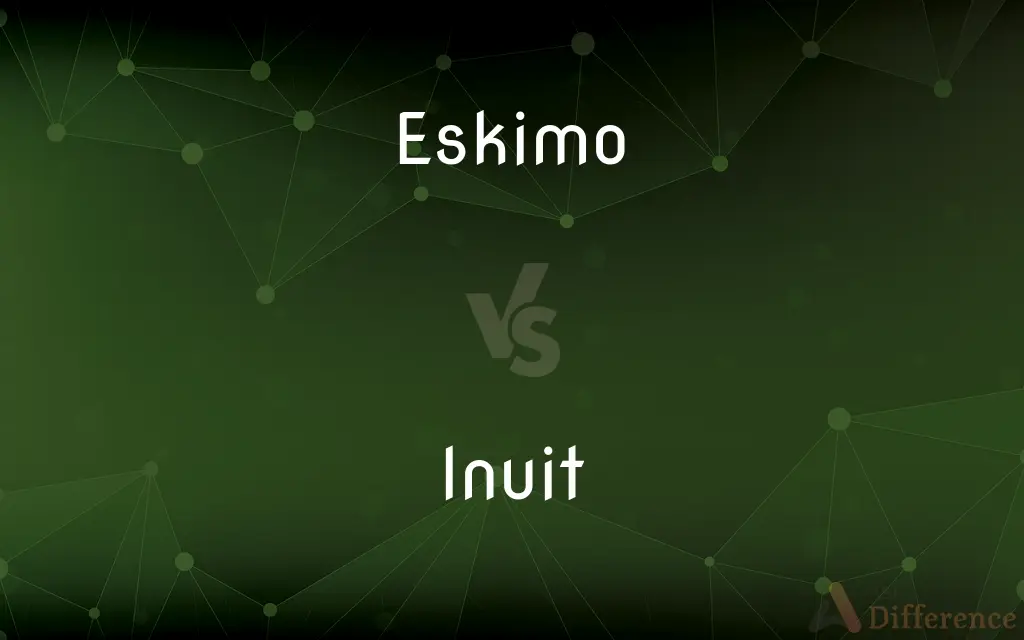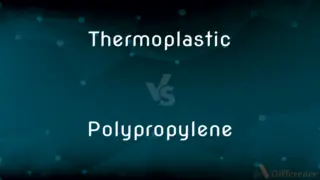Eskimo vs. Inuit — What's the Difference?
Edited by Tayyaba Rehman — By Fiza Rafique — Updated on May 2, 2024
"Eskimo" is a collective term historically used for Indigenous peoples of the Arctic, considered outdated and pejorative; "Inuit" refers to a group of culturally similar Indigenous peoples of the Arctic regions of Greenland, Canada, and Alaska.

Difference Between Eskimo and Inuit
Table of Contents
ADVERTISEMENT
Key Differences
The term "Eskimo" was once widely used to describe Indigenous Arctic peoples in Alaska, Canada, and Greenland. However, "Inuit," which means "the people" in the Inuktitut language, is preferred among these communities, particularly in Canada and Greenland, because it is more specific and culturally respectful.
"Eskimo" is considered derogatory, especially in Canada and Greenland, because it is believed to have been a term given by non-Inuit people and might derive from a phrase meaning "eater of raw meat." Conversely, "Inuit" is embraced by the community it describes and lacks negative connotations.
The Inuit are part of a larger group that also includes the Yupik, who are not called Inuit. This distinction is significant because the term "Eskimo" is still used in Alaska to include both Yupik and Inupiat, underscoring its broader application.
While "Inuit" refers specifically to certain Indigenous peoples and their unique cultural practices, language (Inuktitut), and identity, "Eskimo" lacks this cultural specificity and may lead to generalizations or misunderstandings about distinct groups.
The transition from using "Eskimo" to "Inuit" in official and popular discourse reflects a broader movement towards recognizing and respecting the autonomy and identity preferences of Indigenous communities.
ADVERTISEMENT
Comparison Chart
Meaning
An older term for Arctic Indigenous peoples
Means "the people" in Inuktitut
Usage
Considered pejorative in many areas
Preferred term in Canada and Greenland
Geographic Scope
Includes Inuit and Yupik peoples
Specifically refers to certain groups in Greenland, Canada, and parts of Alaska
Cultural Identity
Less specific, can be seen as derogatory
Culturally specific, embraced by the people it describes
Current Acceptability
Still used in some regions like Alaska
Widely accepted and used by the communities it describes
Compare with Definitions
Eskimo
Still accepted in some regions.
In Alaska, 'Eskimo' encompasses both the Inupiat and Yupik peoples.
Inuit
Specific to certain cultures and languages.
Inuit communities speak variations of the Inuktitut language.
Eskimo
Can carry pejorative overtones.
They avoid using 'Eskimo' as it may be seen as disrespectful.
Inuit
Have unique legal and territorial claims.
The Inuit have established comprehensive land claims agreements.
Eskimo
A general term historically used for some Indigenous Arctic peoples.
The term 'Eskimo' is broadly used in Alaska.
Inuit
Culturally and politically active.
Inuit leaders are influential in Arctic policy discussions.
Eskimo
Linked to historical contexts.
Historical documents frequently use 'Eskimo'.
Inuit
Known for distinct art and crafts.
Inuit art is celebrated for its intricate carvings and prints.
Eskimo
Often replaced by more specific group names.
Many prefer 'Inuit' over 'Eskimo' due to its precision.
Inuit
Indigenous peoples of the Arctic regions of Canada, Greenland, and Alaska.
The Inuit have a rich tradition of oral history.
Eskimo
Eskimo ( ESS-kih-moh) or Eskimos is a term used to refer to two closely related Indigenous peoples: The Inuit (including the Alaskan Iñupiat, the Greenlandic Inuit, and the Canadian Inuit) and the Yupik (or Yuit) of eastern Siberia and Alaska. A related third group, the Aleut, which inhabit the Aleutian Islands, are generally excluded from the definition of Eskimo.
Inuit
The Inuit (; Inuktitut: ᐃᓄᐃᑦ 'the people', singular: Inuk, ᐃᓄᒃ, dual: Inuuk, ᐃᓅᒃ) are a group of culturally similar indigenous peoples inhabiting the Arctic regions of Greenland, Canada, and Alaska (United States). The Inuit languages are part of the Eskimo–Aleut languages also known as Inuit-Yupik-Unangan and also as Eskaleut.
Eskimo
A member of any of a group of peoples inhabiting the Arctic coastal regions of North America and parts of Greenland and northeast Siberia. See Usage Note at Native American.
Inuit
The members of various indigenous peoples inhabiting the Arctic from northwest Alaska eastward to eastern Greenland, particularly those inhabiting Canada.
Eskimo
Any of the languages of the Eskimo peoples.
Inuit
The family of Eskimoan languages spoken by the Inuit.
Eskimo
One of a peculiar race inhabiting Arctic America and Greenland. In many respects the Eskimos resemble the Mongolian race.
Inuit
Any of the Eskimoan languages spoken by the Inuit.
Eskimo
A member of a people inhabiting the Arctic (northern Canada or Greenland or Alaska or eastern Siberia); the Algonquians called them Eskimo (`eaters of raw flesh') but they call themselves the Inuit (`the people')
Inuit
Of or relating to the Inuit or the languages spoken by the Inuit.
Eskimo
The language spoken by the Eskimo people
Inuit
A member of a people inhabiting the Arctic (northern Canada or Greenland or Alaska or eastern Siberia); the Algonquians called them Eskimo (`eaters of raw flesh') but they call themselves the Inuit (`the people')
Common Curiosities
Why is "Inuit" preferred over "Eskimo"?
"Inuit" is culturally specific, embraced by the community, and lacks the negative connotations associated with "Eskimo."
Are the terms "Eskimo" and "Inuit" interchangeable?
No, "Inuit" specifically refers to certain Indigenous groups, whereas "Eskimo" is broader and not preferred.
Where is "Eskimo" still used?
"Eskimo" is still used in Alaska to include both the Yupik and Inupiat peoples.
What languages do the Inuit speak?
The Inuit speak several dialects of the Inuktitut language family.
How do Inuit communities govern themselves?
Inuit communities have various forms of governance, often involving local, regional, and national organizations that manage their affairs.
What are the cultural practices of the Inuit?
The Inuit have a rich cultural heritage that includes unique languages, art, and survival practices adapted to Arctic environments.
What does "Eskimo" mean?
Historically, it's a term used for Indigenous Arctic peoples, but its exact origin and meaning are disputed and considered derogatory by many.
What is the legal status of Inuit in Canada?
In Canada, the Inuit are recognized as one of the Indigenous peoples with specific land claims and self-government rights.
Is it offensive to use "Eskimo"?
In many contexts, especially in Canada and Greenland, it is considered offensive and outdated.
How do Inuit adapt to the Arctic environment?
Inuit have traditionally adapted through skills like hunting, fishing, and crafting clothing suitable for extreme cold.
Share Your Discovery

Previous Comparison
Barry vs. Burry
Next Comparison
Thermoplastic vs. PolypropyleneAuthor Spotlight
Written by
Fiza RafiqueFiza Rafique is a skilled content writer at AskDifference.com, where she meticulously refines and enhances written pieces. Drawing from her vast editorial expertise, Fiza ensures clarity, accuracy, and precision in every article. Passionate about language, she continually seeks to elevate the quality of content for readers worldwide.
Edited by
Tayyaba RehmanTayyaba Rehman is a distinguished writer, currently serving as a primary contributor to askdifference.com. As a researcher in semantics and etymology, Tayyaba's passion for the complexity of languages and their distinctions has found a perfect home on the platform. Tayyaba delves into the intricacies of language, distinguishing between commonly confused words and phrases, thereby providing clarity for readers worldwide.













































